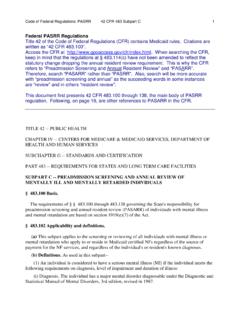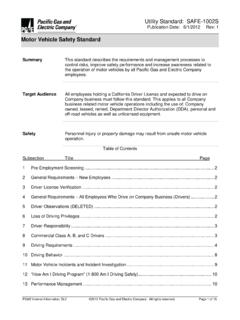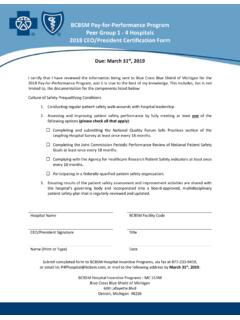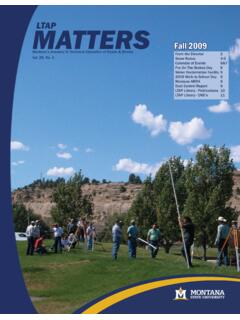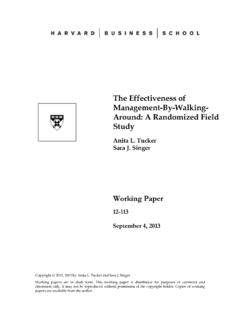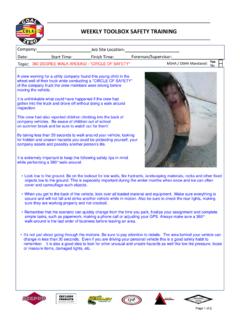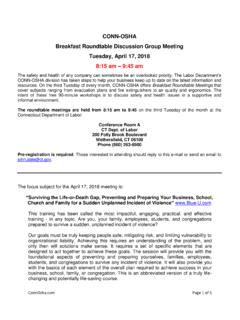Transcription of Best Practices for Safety Walk-Arounds
1 Quarterly Occupational Safety & Health Newsletter, Spring 2018 Page 1 Spring 2018 Tammi M. Goerdt, Director of CE & Outreach, Practices for Safety walk -AroundsIf you re a manager looking for ways to actively improve the Safety of your workplace, you should consider instituting a Safety walk -around program. By regularly inspecting the workplace in person while workers do their jobs and following up on what you learn you can discover hazards you would have otherwise missed and build an organi-zational culture that values Safety . Walk-Arounds can become an important plank in your Safety program.
2 In a three-part series of blog posts, James Loud, MPH, CSP, identi es General Motors, DuPont, the Tennessee Valley Authority, Honeywell, and the Los Alamos National Laboratory as examples of organizations with Safety walk -around you begin your walk -around, determine which areas and tasks in your work-place are most hazardous by reviewing recent injury and incident reports. Make a list of previously identi ed hazards so that you can con rm that they ve been addressed. Meet with Safety representatives, other managers, and, if you have one, your company s Safety committee in order to get their perspectives on your most pressing Safety sure that you know what Safety guidelines you ll need to follow on-site.
3 If the workers you re visiting are required to wear PPE, prep your own and practice using it correctly so you can set a positive , let workers know in advance when you ll be coming and why. Your presence will inevitably a ect how they perform their tasks, but this e ect can be reduced signi cantly if you give them warning and assure them that you re interested in an open, collegial conversation about their Safety Practices and needs. James Loud suggests stating explicitly that the walk -around will be fault-free. You re not going to reprimand workers based on what you observe, but rather look for opportunities to collaborate on a safer your walk -around, keep your group small you should only bring one additional person, or two at the most, for each walk -around, so as to make yourself approachable and skew worker behaviors as little as possible.
4 On entering the worksite, begin by looking for obvious problems like tripping hazards, missing machine guards, poorly maintained equipment, and blocked exits. Ask workers to behave as they normally , start an open-ended conversation with the workers. Ask them questions like, What is the most hazardous part of your job? What do you recommend to eliminate those hazards? How would you report an injury, hazard, or near miss? Ask them if they or anyone they know have ever been injured at this worksite. If they have, ask what caused it and what was done a erward to make their job safer.
5 If you notice a violation of Safety rules or procedures, ask the worker why that happened again, making it clear that you re not here to nd fault. Take detailed notes. A er the walk -around, follow up on what you learned. Make an abatement plan that describes how and when you plan to address the hazards you found. In cases where more complicated e orts may be required, begin by establishing interim controls that can help to mitigate the problem in the meantime. Track your progress and share it with your colleagues. By acting decisively to improve your workers Safety , you can build credibility as a partner, build stronger relationships between management and workers, improve employee morale, and reduce injuries in your workplace.
6 Further Reading Read OSHA s fact sheet on Safety Walk-Arounds . Read James Loud s series on Safety Walk-Arounds : one, two, Occupational Safety & Health Newsletter, Spring 2018 Page 2 Spring 2018 Tammi M. Goerdt, Director of CE & Outreach, What to Do During Severe Spring WeatherSpring weather can be lovely, but it s also unpredictable. A mild breeze and light precipitation in the morning might become an intense thunderstorm before dinner. at s why March 26-30 is Severe Weather Awareness Week. Whether you re at work or at home, you need to know the hazards posed by severe weather and prepare to keep yourself, your coworkers, and your family safe.
7 Common spring hazards include tornadoes, ooding, and lightning an ear out for danger. Be aware of municipal and/or employer weather warning sirens. When you hear one go o , don t just assume it s a drill. Furthermore, take drills seriously as oppor-tunities to learn and practice your employer s Safety policies and kill and injure people by hitting them with ying debris, so the key to staying safe during a tornado is to nd a sturdy shelter. Basements or other underground structures are ideal. If you can t be underground, your second best option is to nd a small, interior room away from windows, such as a closet or bathroom.
8 Get low and cover your head to protect from ying debris. If you re at work, your facility should have an emergency plan that de nes where employees are expected to go during a tornado and how they should get there. If you don t know that plan, it s likely your coworkers don t know it either; if possible, you should ask management or your Safety manager to make an the di erence between a tornado watch and a tornado warning. A tornado watch means at least one tornado is expected to form in your area soon. You should check your supplies and prepare to take shelter in a safe place.
9 A tornado warning means that one or more tornadoes have been found in your area and you need to take shelter as quickly as don t want to be on the road during a tornado, but some-times it happens. If you re driving during a tornado warning, even if it s for work, try to nd a sturdy shelter like a truck stop, convenience store, or restaurant. Don t try to outrun a tornado in your vehicle. If you see one in the distance, change course and drive toward shelter. Never try to use a highway overpass as a shelter, don t get under your vehicle, and don t hide inside a ditch except as a last resort.
10 If your car is stuck in heavy tra c, get out and run as far from the cars as you can before getting low. If you re stuck in your car, turn o your engine, keep your seatbelt on, and keep your head covered and below your windshield and ooding due to rapid snow melt and/or heavy spring rain can be especially hazardous for people who drive as part of their job. According to the National Oceanic and Atmospheric Admin-istration (NOAA), more people are killed by ooding than any other single severe weather hazard, and more than half of all ood-related deaths result from vehicles being swept downstream.
